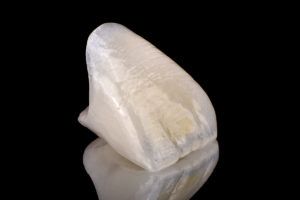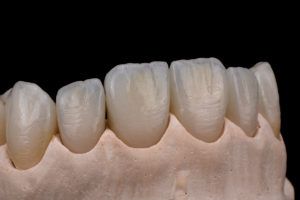G-CAM is a product in a disc format of 98.5 mm (universal anchorage) or 95 mm (Zirkonzahn anchorage), made for the manufacture of dental prostheses using the CAD/CAM system.
FAQs
What is G-CAM?
What type of material is it?
G-CAM is a thermostable acrylic with a principal base of polymethylmethacrylate resin doped with graphene (allotropic form of carbon).
What is the difference between multichroma and multilayer format?
Multichroma format must not be mistaken with the multilayer format.
Multichroma format is a new concept created by Graphenano Dental in which the transmission of background colours of dental restorations is simplified with the intention of achieving the naturalness of the restorations, imitating optical effects of natural teeth.
The regular version that the sector offers is a multilayer format of horizontal setup. This format generates “band effects” of transition between layers, which worsen in situations of non-harmonic anterior groups and in speed curves of posterior sectors. By contrast, the configuration of natural structures is vertical, so the depth and thicknesses create multichromatic light effects. In other words, the solution offered by dental sector is a horizontal colours configuration, while the nature of the tooth is vertical.
As it would be very difficult to obtain an arrangement of vertical layers in a disc format for multiple unit restorations, Graphenano Dental achieves these natural effects through the control of thicknesses with single-layer translucent colours. When the tooth is out of the mouth, the most translucent area is the cervical edge (Image 1); but, when the tooth is adapted onto the model, the chroma is enhanced in the cervical area and the most translucent area is now the incisal edge, in the same way as in a natural setup (Image 2).

Image 1 |

Image 2 |
What improvements does it present?
Our company is invested in the improvement of materials by reinforcing their matrices with graphene.
Resin, which is the most used material in dentistry, has weaknesses due to being a very rigid and brittle plastic, it has very little surface hardness and absorbs liquids, due to this, it is not usually used for definitive treatments.
With our graphene doping, we can make resin a more compact material, more flexible, with greater hardness and that does not absorb liquids, thus providing it with characteristics that make it unbeatable and suitable for definitive treatments.
What is graphene?
Graphene is a nanomaterial which we synthesize from carbon. At our company we not only manufacture graphene, but we understand it and apply it to achieve mechanical and biological improvements; this makes us leaders in the sector.
How do we use G-CAM?
The disc format is indicated for milling using the CAD/CAM system. Its milling strategy is like that of PMMA without irrigation.
The G-CAM disc is used dry, so it will be necessary to suction any debris resulting from the drilling operation. The drills may break if improper tools are used. Although graphene helps to dissipate the heating of materials, an inappropriate strategy may cause the overheating and deformation of the material.
What kind of protheses can be made with G-CAM?
This material is designed for any prosthetic treatment, from removable braces to definitive implantology.
What is the best material for the structures on implants in which the graphene crowns are cemented? Can the complete structure be made with G-CAM?
The concept of the material is the monolithic application, that is, with the G-CAM material can be made from a complete prosthesis to a prosthetic rehabilitation on implants, crowns on existing teeth, veneers, dental inlays and onlays, etc. Even so, it can also be combined with metal, peek, polyamide or zirconium structures.
With what material do graphene crowns be cement to the structure?
If the structure is a natural tooth, the protocol is the usual one: by isolating the piece to etch with acid and surface activation. If the structure is a abutment onto the implant or interface, a superficial sandblasting treatment and activation with metallic connector is recommended.
The treatment of the G-CAM structure does not change. We always recommend internal sandblasting and cleaning with ethyl alcohol. The ethyl alcohol helps to eliminate the surface tension of the structure.
Which finishing techniques are employed?
The techniques we have developed range from surface make-up to complex stratification with a monolithic composite technique; always with light-cured products.
What is its wear in front of natural enamel when it is antagonist?
The objective is for the material to works biomechanically in terms of bending, compressive load absorption and surface hardness, so that the wear is controlled without affecting the antagonist teeth. The problem of composite materials (composite hybrids with ceramics), conventional ceramics or zirconium is that their hardness and abrasion can affect the natural teeth.
Graphenano Dental has carried out different studies with Spanish and Italian universities about aging and wear of the material. Results will be public when these universities consider it convenient.
You can know the mechanical and chemical properties of the product on this website.
What advantages does the laboratory obtain by using G-CAM?
Work in laboratories is always hard and tedious, performing a regular rehabilitation can take more than 20 hours of work. With our G-CAM discs, working time is optimized, since once it is milled, it is not necessary to synthesize or vitrify it, it is simply made-up with light-cured stains and it is ready in half an hour.
What are the ideal thickness of the crowns or structures?
Is there a maximum space between two implants (pontics)?
This question is very relative. Graphenano Dental offers a material with improved mechanical and biological properties. To evaluate the resistance in the pontic areas, between abutments, there is a need to analyse the extension of the section, prosthetic height and occlusion, to make a design according to those needs.
We have done works with up to 4 intermediate pontics, but we have reinforced the connections so that strengh and structural stability were balanced. The success of the work depends on the customized planning.
Does G-CAM break in the mouth? In case of fracture, what is the best material to be repaired?
If G-CAM breaks in the mouth, although this happening is highly unlikely, it can be repaired in the mouth with PMMA or light-curing composites, without having to remove it.
Our material is based on polymeric matrices of polymethylmethacrylate with a functionalization of the nanoparticles (graphene). This functionalization allows a better integration and adhesion of the product. Therefore, G-CAM can be repaired directly with PMMA or light-curing composites, following a cleaning protocol and activation of the surface by sandblasting and chemical connector.
What is its fracture strength? Have dynamic or static studies been carried out?
The fracture strength or elastic limit is about 140 MPa, according to ISO 13585. Static tests have been performed on standardized test tubes.
Is it a radiopaque material?
Graphene itself is radiopaque, but it is true that the graphene proportions on the material are very small. Nanotechnology modifies the properties of materials thanks to their surface areas and the dispersion that is achieved. That is why its radiopaque threshold is low, but it can be seen in a clinical CBCT.
We have an advanced development with the contribution of TIO2 microparticles where we raise the radiopaque threshold.
In which colours and measurements is G-CAM available?
G-CAM enters the market with 9 main colors, according to the VITA Classical guide: A1, A2, A3, A3’5, B2, C2, CL2, transparent and pink.
The available widths –in all of the aforementioned colours– range from 14 mm to 26 mm. We can also manufacture special 30 mm discs.
If a specific disc (color/width combination) which we did not have pre-manufactured were needed, we could have it packaged and ready for shipment within 48 hours.
Where can G-CAM discs be purchased?
The G-CAM discs can be purchased in our online shop, and through authorized distributors.




